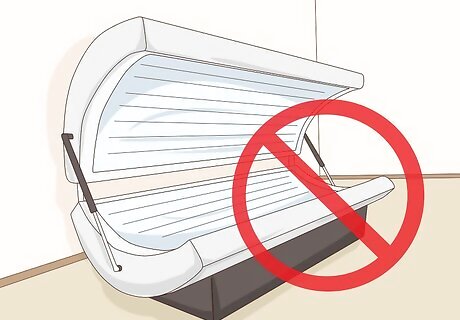
views
Applying Prescribed Topical Creams

Ask your doctor about using topical steroids. Steroid creams are prescribed by dermatologists for a range of skin conditions, and are often a first-line treatment for IGH. Your doctor will prescribe a specific topical steroid and explain how and how often to apply the cream to your IGH spots. You'll usually apply the topical steroid once a day for at least 2 weeks, and probably longer before seeing results. Side effects from steroid creams are uncommon, but can include redness, thinning of the skin, or even permanent pigmentation changes. If you have IGH on your face or other areas where your skin is thinner, you'll need to use a lower concentration of topical steroid to reduce the risk of skin inflammation.

Discuss using retinoids such as tretinoin. If topical steroids cause unwanted side effects or you'd prefer to avoid them for other reasons, your doctor might recommend retinoids instead. The retinoid tretinoin is often prescribed for IGH as a topical cream because it is easy to apply and has mild side effects. Retinoids are applied once daily, usually at night. It will take several weeks or possibly months to achieve noticeable results. If you experience any side effects, they will usually be limited to itching, redness, or dryness at the application site. Retinoids are chemically derived from Vitamin A and are useful for a range of skin conditions.

Consider trying a topical NSAID like pimecrolimus. If topical steroids are the typical first treatment for IGH, topical NSAIDs share second place with retinoids. Your doctor will start you on one of them and evaluate your results. NSAID creams such as pimecrolimus reduce inflammation and can help reduce the appearance of IGH spots over time. Pimecrolimus 1% cream may cause localized burning or stinging, but these issues typically vanish after a few applications. It can also cause acne flares in the application area in some cases, but this side effect usually goes away fairly quickly with regular use. You'll often apply this medication twice per day for at least 2 weeks, and probably longer, in order to achieve results.
Damaging Skin Therapeutically to Remove IGH

Try weekly laser therapy treatments for about a month. If your dermatologist offers laser treatments, you’ll likely need to make quick visits each week for about a month. Spot treatments with the laser are usually painless, although you may experience some burning or redness in the treated areas. Like cryotherapy, dermabrasion, and chemical peels, laser treatments intentionally cause minor damage to the skin. As the skin repairs and regenerates, the IGH spots should be minimized or disappear completely. All of these therapeutic skin damage options seem to produce roughly the same rate of success, although there isn't much detailed research on them when it comes to treating IGH. Your doctor will probably first recommend topical creams (like steroids or retinoids), then if necessary move on to trying one therapeutic skin damage method at a time until you see the desired results.

Consider spot cryotherapy treatments with liquid nitrogen. When treating IGH with cryotherapy, your dermatologist will essentially dip a small tool akin to a cotton swab into liquid nitrogen and hold it to an IGH spot for 5-10 seconds. At most, you may experience a minor and short-lived burning sensation where the treatment occurs. One study showed cryotherapy is effective at removing IGH spots (within a month or so) in roughly 80% of all cases, which is in the same range as other therapeutic skin damage methods.

Undergo a chemical peel with 88% phenol or a similar product. If you undergo a phenol (or similar) chemical peel at your doctor’s office, you may expect your IGH spots to disappear within several weeks roughly two-thirds of the time. In some cases, though, you may experience scabbing over your IGH spots, or even (in rare cases) ulceration of these spots. You may also experience hyperpigmentation in rare cases, which means the IGH spots will go from being much lighter than your surrounding skin to noticeably darker.

Look into Intense Pulse Light (IPL) treatments. Intense Pulse Light treatments may help to even out your skin tone. The treatment uses pulses of bright light to improve the appearance of the skin. It can cause some stinging, so you will need an application of a topical anesthetic before your treatment. You will also need to wear dark glasses to protect your eyes. IPL treatments take about 20 to 30 minutes per session, and you will need 3 to 6 treatments performed 1 month apart. You may experience some redness and peeling of your skin after treatment.
Reducing Your Chances of Getting IGH Spots

Wear sunscreen every day. The exact causes of IGH are still not fully known, but dermatological experts agree that long-term sun exposure is a major factor in practically every case. To reduce your exposure to the sun’s UV rays, apply a broad-spectrum sunscreen to your exposed skin every time you go outside, even on cloudy days. IGH spots nearly always occur in areas that are regularly exposed to the sun’s UV rays, such as the lower legs and arms, the face, and the back of the neck.

Cover exposed skin. Along with using sunscreen when going outdoors, it’s also a smart idea to wear a broad-brimmed hat and sunglasses to protect your head, face, and eyes. Consider also wearing long sleeves and pants on sunny days. Look for hats and clothing made of fabrics that provide UVA/UVB protection by checking the labels. Don’t go out in the sun between 10 am and 4 pm because this is when the sun is the most powerful.

Don’t use tanning beds. Your quest to have a deep tan right now might lead to you having lots of small white spots on your skin later. Tanning beds can cause a host of problematic skin conditions and should be avoided in all cases. People who start using tanning beds regularly before the age of 35 increase their risk of developing melanoma (skin cancer) by 75 percent.
Maintain a healthy immune system. Autoimmune disorders predispose you to IGH, so do what you can to keep your immune system healthy. If you have an autoimmune disorder, make sure to seek treatment from your physician.
Avoid skin trauma. Trauma to your skin can also predispose you to IGH, so make sure to protect your skin from injury as much as possible. If you get a skin injury, such as a burn or cut, then make sure to have it treated right away.

See if IGH runs in your family. Even if you take every recommended sun protection measure, you may end up with IGH spots due to genetics. Experts aren’t entirely sure why, but IGH seems to run in families. If this is the case for you, though, don’t use it as an excuse not to bother protecting your skin from the sun. IGH spots are more common on people with fair skin, but are more noticeable on people with darker skin.




















Comments
0 comment